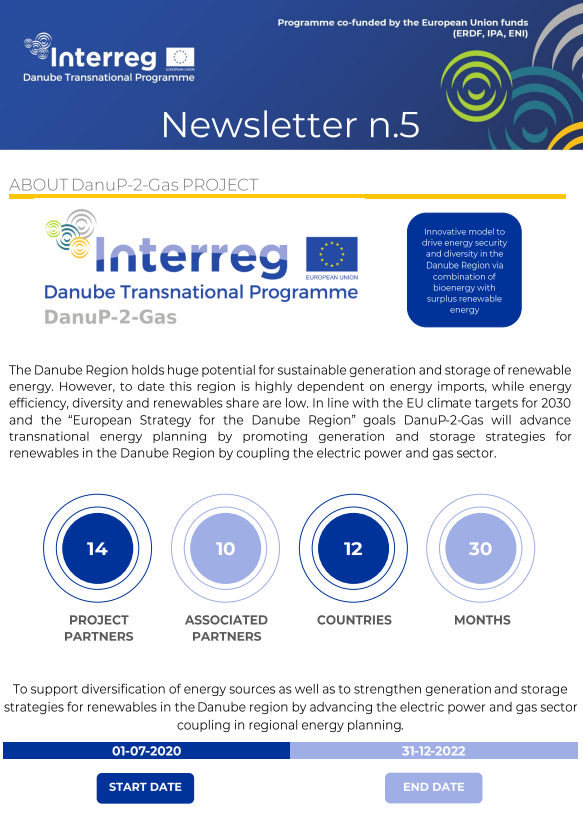Project HARMONIA Presentation
Below you can watch the presentation video of the HARMONIA project. Further details about the project can be found by accessing this link https://urbasofia.eu/en/harmonia/
DanuP-2-Gas Newsltter n.9
We are happy to let you know that the 8th newsletter of the DanuP-2-Gas Project is out and is available in both English and Romanian.
For the Newsletter in English click on the image below.

For the Romanian version of the newsletter click here.
DanuP-2-Gas Newsletter n.8
We are happy to let you know that the 8th newsletter of the DanuP-2-Gas Project is out and is available in both English and Romanian.
For the Newsletter in English click on the image below.

For the Romanian version of the newsletter click here.
ISTER Benchmarking Toolkit

You can now find and download the ISTER Common Benchmarking Toolkit directly from our website!
This toolkit may be of interest to you if you are a public authority, policy maker or any other urban actor interested in the protection, valorization, management and sustainable use of the Cultural Heritage and more specifically of the Cultural Routes.
It will take you from understanding if and to what extent your cultural route meets a set of criteria for fulfilling its potential in different stages, through an in-depth understanding of the eligibility criteria that have to be met in order to receive the “Cultural Route of the Council of Europe certification”, straightforward to the importance, criteria to be met, policy guidelines, practical methods and best practices applicable for five priority fields of action set by the European Council:
- Cooperation in research and development
- Enhancement of memory, history and European heritage
- Cultural and educational exchanges for young Europeans
- Contemporary cultural and artistic practice
- Cultural tourism and sustainable cultural development
At the end you will find a set of recommendations specific for each country part of ISTER project which are based on the results and findings of the first round of capacity building workshops in relation with the documentation made for each field of action.

Image source: https://edubirdie.com/blog/how-to-write-research-paper-conclusion
Urbasofia has recently presented ISTER project at the 1st international conference of the Interreg Danube project “Living Danube Limes”. The presentation focused on the potential of Roman Routes for linking people and places as well as past and contemporaneity. More specifically, the emphasis was put on how museums support and enhance storytelling starting from the Roman routes, and in this regard, specific ongoing and future activities were detailed during the presentation.
ISTER project was also presented by the lead partner, as a real-world example within the workshop “Cultural heritage, cohesion policies and wellbeing: a virtuous circle” at European Week of Regions and Cities (#EURegionsWeek). The presentation focused on the story behind ISTER project, on the steps made so far for its development, as well as on the contributions it makes on societal well-being in terms of quality of life, social cohesion, and material conditions.
A series of conclusions and recommendations were outlined by the end of the workshop based on the knowledge and rich experience of Urbasofia, HERIWELL Consortium and ESPON EGTC. You can read some of them below:
- We need to increase awareness and capacity among policymakers and stakeholders to mainstream Cultural Heritage. In this sense, a very concrete step to do it is the mutual learning programs, in which policymakers and stakeholders can exchange experience on what works and what doesn’t work in the field;
- We need strategic plans based on CH, that respond to the problems of relaunching the economies, but also to the need to innovate them. These plans must be based on a broader definition of sustainability;
- Sustainability must consider the impact of the cultural dimension in interaction with the society (community), the economy (business), and the environment (correct use of limited resources);
- It is important to have a systematic approach: start by knowing the problems, mapping, evaluating, diagnosing, making a strategic document and taking action.
- Some questions should be raised when involving stakeholders: Who is the subject we want to involve?, What is the urban context?, Why and where they should be placed in the process? And how do we work with them?;
- When are talking about the „who”, we should start looking also on those who are marginalized, at those who are not involved now.
Ister Workshop
SAVE THE DATE!
Workshop on “Cultural heritage, cohesion policies and wellbeing: a virtuous circle” during #EURegionsWeek 2021 – OCTOBER 13
Dear colleagues and friends,
We are delighted to invite you to the workshop “Cultural heritage, cohesion policies and wellbeing: a virtuous circle” which will take place on October 13, 2021 from 11:30 AM to 1:00 PM, in the framework of the #EURegionsWeek 2021.
The workshop aims to discuss the contribution of cultural heritage to societal well-being and local development, drawing on the rich experience of the HERIWELL Consortium and ESPON EGTC, URBASOFIA, and the EU- funded project Cultural Heritage in Action.
What is it about?
- The session will address the challenge of aligning policies across European cultural heritage territories, in order to contribute to territorial development and foster societal well-being.
- It will highlight concrete examples and case-studies on how cultural heritage can act as a catalyst for societal well-being, territorial competitiveness and sustainable growth.
- It will highlight the contribution of EU funds to unlock the potential of cultural heritage for territorial development and wellbeing.
- It will bring together heritage experts, public institutions and civil society stakeholders in a multi-disciplinary dialogue.
Structure of the workshop:
- Setting the theoretical background: key concepts
- The contribution of cohesion policy to unlocking the potential of cultural heritage
- 2 Real world examples:
- The way forward: Recommendations for future policy actions
How to register?
- Register to the workshop now! To do so, simply access the official EUWeek page. Please, note you have to create a profile to register. This will only take you a few minutes.
We very much look forward to welcoming you to this inspiring Workshop!




